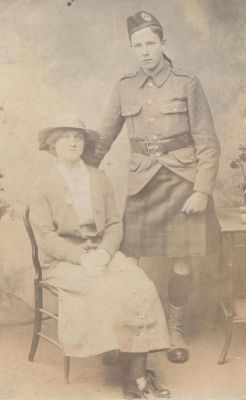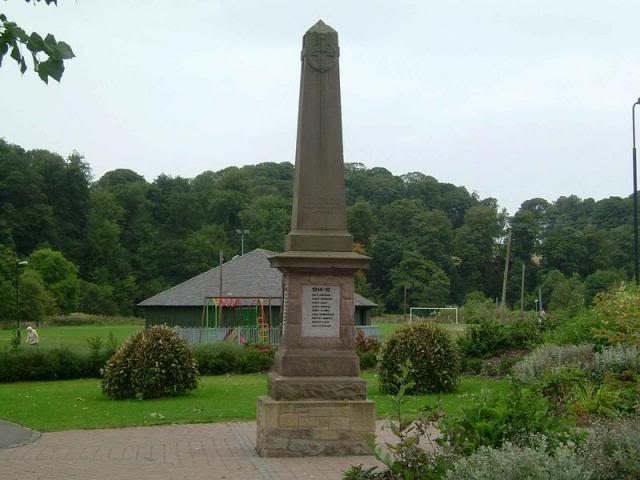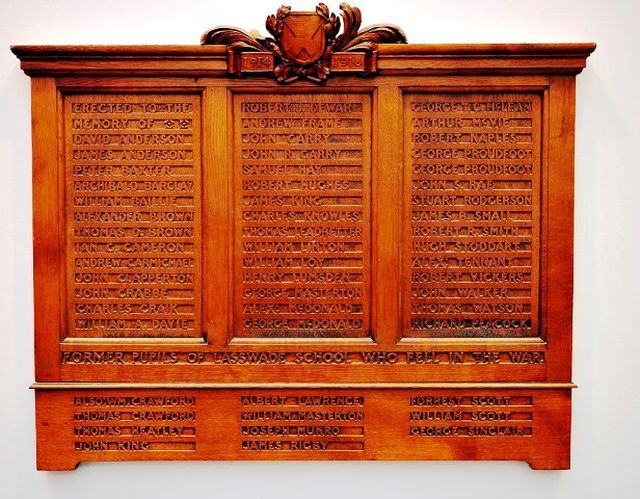Private George Masterton
 S/15341 7th Battalion
S/15341 7th Battalion
Queen's Own Cameron Highlanders
killed in action 3rd November 1915
aged 18
Loos Memorial Panel 119-124
Lasswade War Memorial
Son of George Masterton and Janet Calder
Lasswade, Midlothian, Scotland
Genealogy
George Masterton was born in Anderson's Buildings, Lasswade, Midlothian, Scotland on 3 March 1897, the third of a family of eleven born to George Masterton, breaker man in a paper mill, and Janet Calder. By 1911, the family, including George (14, at school) was living in Kevock Cottages, Lasswade, Midlothian, Scotland. By 1914, George was also employed as a paper maker when he volunteered for the Cameron Highlanders on 5th September 1914, and joined the battalion in Inverness on the following day. Further details of George, his parents and ten siblings and the extended family of Mastertons from the Biggar area can be found at the following link. George's uncle, William Nimmo Masterton, was also to lose his life in the Great War.
His War
The 7th (Service) Battalion Queen's Own Cameron Highlanders was a battalion of the New Armies formed in Inverness in September 1914 and came under orders of 44th Brigade in 15th (Scottish) Division. George joined the battalion on 6th September 1914 in Inverness, declaring his age to be 19 years and 284 days. In fact, he was only 17 years and 184 days old. Like many young lads keen to serve, he had added more than two years to his age to be eligible to enlist and serve overseas (for which the minimum age was 19). He was 5ft 7in tall, with dark hair and dark blue eyes. The battalion landed in Boulogne on 8 July 1915 when George was still 18 years old.
The 44th Brigade lost 75 per cent of its strength on 25th September 1915, the first day of the Battle of Loos. George was lucky to survive that.
The 7th Camerons, alongside the 10th Gordons in which David Masterton lost his life, were in support of the leading columns on the right of the Division
in the first wave of the attack on Loos village and Hill 70 beyond.
The Fifteenth (Scottish) Division 1914-1919
25 September 1915
At 5.50 A.M. the gas attack commenced, and, to an onlooker, every gun on the Corps front appeared to redouble its fire. The effect of the white clouds of smoke rolling slowly towards the enemy trenches was extraordinary. It looked as if a curtain, stabbed here and there with the red bursts of shrapnel, had been drawn across the Division front...
At 6.30 A.M. the leading lines of assaulting columns left their trtenches. Gaps had been cut diagonally in the British wire, and men had no difficulty in getting through, but directly they left the shelter of the trenches and the enemy became aware of their approach, they encountered an extremely heavy rifle and machine-gun fire. This was particularly so on the right of the 44th Brigade, where an enemy redoubt on the Loos-Philosophe road, known as the "Jew's Nose," was responsible for at least half the casualties suffered by the 9th Black Watch on that day.
At 7.5 A.M. the whole of the 44th and 46th Brigades were over the German front-line trenches and pushing on towards Loos, with the exception of No. 5 Column, which was held up on the left. ...
After the front-line German trenches were captured, the assaulting columns swept down the slopes to Loos village, meeting with little opposition until they reached its western edge. Here they found uncut wire, and the 44th Brigade came under hot rifle and machine-gun fire from the houses in Loos itself. Nothing, however, could stop the impetus of the attack, and the remnants of the 9th Black Watch and 8th Seaforths, now reinforced by the 10th Gordons and 7th Camerons, forced their way into the village. Here fierce hand-to-hand and house-to-house fighting took place. Street barricades were stormed one by one, and many prisoners taken....In spite of all opposition, using bombs freely, and never giving the enemy time to rally, the 44th Brigade penetrated the village, and at 8 A.M. its leading lines were reported advancing up the western slope of Hill 70.
At 6 P.M. what remained of the 44th and 46th Brigades were well-nigh exhausted. They had fought continuously for twelve hours, had penetrated four German lines to a depth of over 3000 yards, and had lost about 75 per cent of their fighting strength. General McCracken decided to withdraw the 44th Brigade into Divisional reserve behind Loos....
After Loos it was imperative that the Division should be given time to reorganise and rest. Conditions did not permit of this being done at once....it was not until October 3 that the Division marched to Lillers and became IV. Corps reserve....By October 12 most units were almost up to strength, classes of instruction were started, and training carried out.
The period of rest allowed to the Division was not long. The enemy was still endeavouring to retake the ground he had lost on September 25, and the situation was somewhat disquieting... At the conclusion of the move the 44th and 46th Brigades were billeted in Noeux-les-Mines..On the 18th orders were received that the Division would take over the front-line trenches then held by the 12th Division...
Owing to the failure to capture the Hollenzollern Redoubt and Puits 14 bis east of Loos, the whole of the British area between these points was under direct observation by the enemy... Throughout the period October 19 to December 15 the enemy systematically shelled the area, especially the front line south of Hohenzollern Redoubt, and retaliatory fire did not stop his activity.

[The 7th Cameron Highlanders in the 44th Brigade took its turn on the front line. George was killed on 3rd November by an enemy shell.]
The Fifteenth (Scottish) Division 1914-1919
J Stewart and John Buchan
1926
On 3rd November 1915, George was one of eleven killed and nineteen wounded that day by the enemy shelling referred to in the Divisional History. George's body was never found, and like thousands of his comrades, his commemoration in the field is a name on the Loos Memorial. But his hometown also remembers him, on the Lasswade Memorial and the Lasswade High School Memorial.


George's name on Lasswade War Memorial is at the foot of this panel.

George's name on Lasswade High School Memorial is on the central upper panel, three names from the bottom. Note his uncle William's name in the lower central panel.
Unit War Diary: 7th Battalion Cameron Highlanders
Trenches: Nov 2 1915: Relieved 8th Seaforths in front line trenches, the right sector formerly occupied by A Co. was taken over by 10th Gordons, our front line was held, on the left, by 3 Platoons of B. Co with one in support, and, on the right, 3 Platoons of C Company with one in support, the remainder of the support trench was held by D Co to cover gap between 10th Gordons and our right. A Co were in local reserve line previously held by B Co. In the machine gun section in C Co's line 3 men were buried by an enemy shell one of whom was killed. Weather wet & cold, trenches very bad.
Nov 3 1915: In the afternoon a heavy gun situated to the right of our line in the direction of Hulluch opened an enfilading fire on the right of B Co's line, killing 11 men and wounding 19 & doing considerable damage to trench.
National Archives
Kew, London
Unit War Diaries: WO 95/1941/1
15 Division; 44 Infantry Brigade; 7 Battalion Cameron Highlanders
July 1915 - August 1918
Dalkeith Advertiser
Intimation has been received of the death in action in France, on 3 November 1915, of Private Geo. Masterton, Kevock, Lasswade. Deceased, who was only eighteen years of age, was serving with the 7th Cameron Highlanders when he met his death.
Dalkeith Advertiser
Dalkeith
25 November 1915
Other Sources
- George Masterton Service Record
- Commonwealth War Graves Commission
- Scottish National War Memorial
- George Masterton Medal Roll Index Card
- George Masterton Medal Roll-Victory and War
- George Masterton Medal Roll-Star
- George Masterton's Deceased Soldier's Effects
- George Masterton in IWM Lives of the First World War
- Medals: Victory, British War, 1914-15 Star